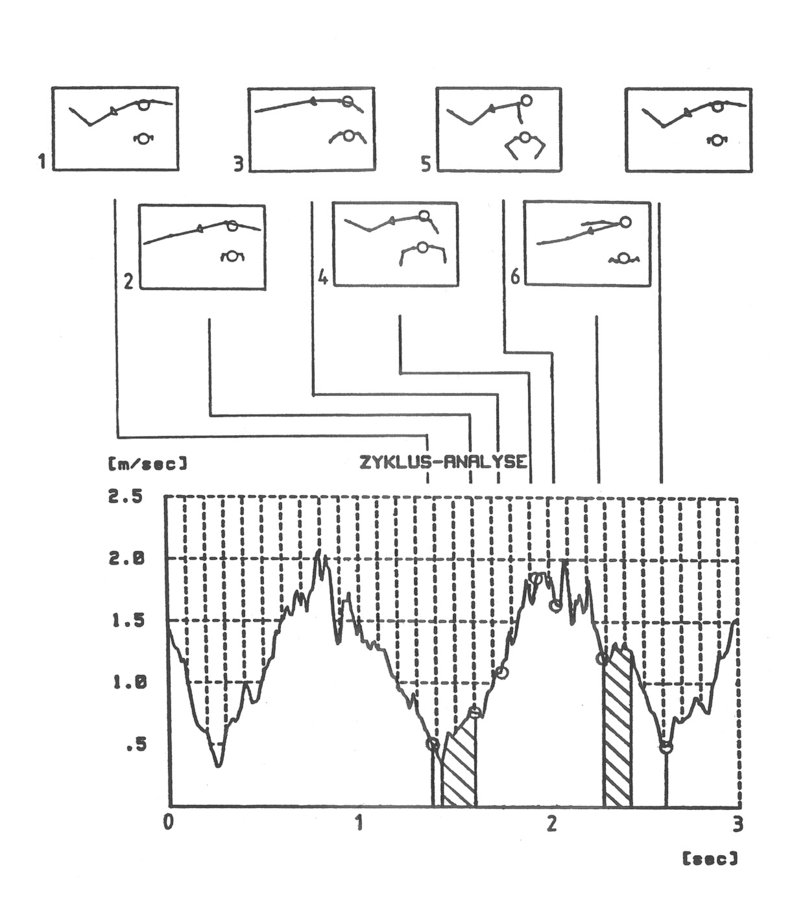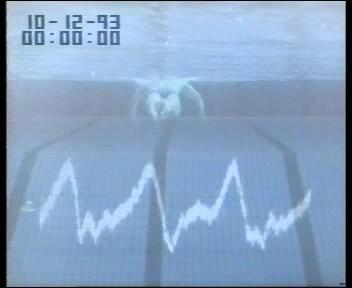Leiter: Univ.-Prof. Dr. habil. Volker Zschorlich
Tel.: 0381/498 2746
The functionale role of the velocity fluctuation in swimming
Introduction
The aim of this study was to investigate the propulsive phases of swimming with the aid of real time intracycle velocity analysis. The basic idea in consideration of velocity fluctuation in swimming was to have a detailed look at the specific propulsive effects of the individual movement patterns. The intracycle velocity fluctuation pattern has an indicator function about movement coordination quality.
Methodology
Different measurement principles (1,2) are to be determined to measure velocities in the fluid medium, water. For reasons of unrestricted movement and simple technical realisation which also includes robustness and preciseness of the measurement apparatus. An anemometer based impeller was used. The impeller is equipped with a needle-bearing mounted blade wheel of low friction. The sensor is characterised by its high insensitiveness with regard to water streaming in at an oblique angle. At an angle of 30 degrees the error rate is about 5%. The inertia of the measuring system can be neglected in practical application, because the weight of the blade wheel is only 0.2 grams. The sensitiveness of the sensor is determined in the medium water with a flow velocity of only 0.03 m/sec. The principle for measurements with this sensor is effected by a blade wheel that takes up a number of revolutions proportional to the flow velocity. The measurement of these revolutions is carried out mechanically via an inductive approximation switch. These generated electrical signals are transformed by means of a Schmitt-Trigger and submitted to a digital processing unit. This processor works in real time. Thus a direct evaluation of the velocity curves is possible at the pool side. It should, however, be emphasised, that this procedure does not primarily aim at the quantitative acquisition of the overall velocity, but at a qualitative evaluation (3) of the intracycle velocity fluctuations.
Discussion
The procedure of the intracycle velocity measurements allows the coach to optimise the motion pattern interactively with the athlete. It is also evident, however, that the optimisation of a motion pattern can only occur with due consideration to athlete condition (e.g. strength, endurance, performance) and also in relation to psychological factors (focussing attention, performance motivation, self-evaluation ...). Here, biomechanics offers a qualitative method in the assessment of velocity fluctuation and modification of technique in swimming. Data on the appearance of the velocity pattern in top athletes are also recorded. Improvement can then be made in their movement pattern, to get better results in the propelling movement phase and to get lower deceleration in movement phases with high drag forces (water resistance). The swimmer has to avoid major velocity fluctuations but it is impossible to avoid them completely. The acceleration pattern is also important to assess. With this relationship we can see in which movement phase the swimmer works efficiently for propulsion. The measurement of the velocity fluctuation is possible over each competition distance.
The technique analysis could be carried out for all competition strokes. The data are calculated in real time and displayed simultaneously on a video-screen with the underwater video picture of the swimmer. With the measurement of the intracycle velocity and acceleration pattern we can optimise the movement coordination of an individual swimmer during technique training.
Reference
- Karpovich, P.V. Res Quart 421-28, 1930.
- Kent. M.R. et al. Swimming II, 58-64, 1975.
- Zschorlich et al. Schwimmtrainer Vol 56/57:13-21, 1988.


